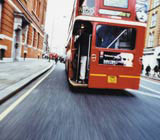Mind the gap
There is a yawning disparity between what the public expects from public transport and the service provided. This shortfall has to be addressed if people are to be lured out of their cars, says Ian Scoley of Priestman Goode

Making the case for public transport versus cars is becoming more difficult, but increasingly important. Petrol companies are developing cleaner fuel, and recent claims that cars are now Greener than trains are worrying. So how do we safeguard against a grid-locked future, with more and more motorways invading the countryside? The solution is the creation of a truly integrated public transport system, that provides a valid alternative to the car and is not a worthy social and ecological choice, but the norm.
Enter design. The role of ‘sustainable’ design within transport is different to that of traditional product design: the sheer size, complexity and timescales involved in public transport work conspire against the kind of direct, detailed input that designers strive for. But without doubt, the transport industry is making leaps and bounds in terms of design, service and environmental awareness. Although emissions and pollution control are inevitable buzzwords, a more important design issue is the way various modes of transport are operated. In short, in order for public transport to be effective and sustainable, it needs to be used by as many people as possible for as long as possible.
Comfort, cost, reliability and convenience are just a few reasons why passengers choose one transport medium over another. But a desire for privacy and greater control over their personal environment are the fundamental issues that make public transport design so challenging and explain why people are so in love with their cars.
In a car, passengers are in control of their environment and experience levels of comfort and quality that they enjoy at home. But with public transport, without the benefit of true mass production and with the added complication of the most stringent safety and environmental standards in industry, reproducing these experiences is a challenge.
Materials we take for granted, such as wood, glass or even clear plastic become major issues of ‘certification’, so widespread use of them can be problematic. Injection mouldings can only be produced in a limited palette of certified materials. But passengers don’t care about certification and only see inferior standards. By working with progressive manufacturers, the designer can play an influential role, pushing the boundaries of certification in order to close the gap between reality and expectation.
If we are to lure commuters out of their cars we have to look at how transport networks are used and how to improve integration between them. One leg of a journey cannot be considered in isolation. The passenger’s experience is not the journey from Heathrow to Dubai or Victoria to Clapham, it is from their front door to the office, from their home to their hotel on the beach. Every aspect of this journey affects how an individual chooses to travel from A to B. Putting passengers in control of this will influence their choice.
The redesign of existing vehicles may introduce new standards, but it will often do away with the old. The iconic London Routemaster ‘hop on, hop off’ bus is being controversially phased out in favour of the new ‘bendy-buses’, complete with optimised interior space, air-conditioned saloons and easy access facilities. (Inquiries into a recent spate of on-board fires are still ongoing). Similarly, the old slam-door trains, berated as death traps, are being replaced by new rolling stock offering the regulation amount of seating and aisle space for optimal performance.
However, the old buses are much more flexible in the urban environment. You can’t sprint to the next set of lights and jump on a bendy bus if you miss one at the stop. And the pre-pay ticket, which normally speeds up the boarding process, means you no longer have the option of hailing a taxi when the information displayed on the bus stop proves to be a work of fiction.
What about the future? Problems inevitably occur within vast public transport networks. So any system that can reliably inform passengers of alternatives without the stranded commuter scouring through complex route plans and timetables or worrying about transferability of tickets would be a benefit.
Communication must be at the root of creating a sustainable transport system. First, communication between transport operators on issues of infrastructure and points of interchange between transport modes; second, communication to the passenger about how these systems integrate. Finally, all transport systems need to be intuitive to the passenger, with clear navigation and communication.
Is mass transportation a sustainable enterprise? Certainly, but it is a long and laborious process. The groundwork for integrated transport in London and other UK cities has started to be laid. With significant design intervention, the complex relationship between transport operators, Government and passengers can become more effective and provide us with a more sustainable future.
Ian Scoley is director at Priestman Goode
-
Post a comment




